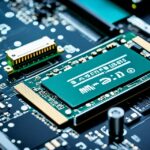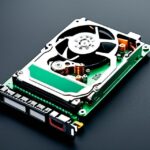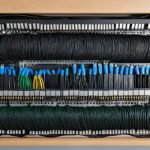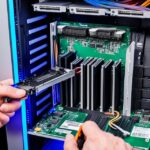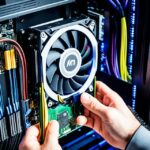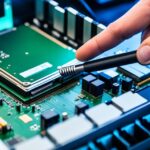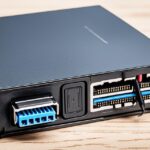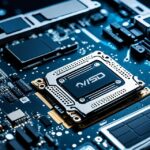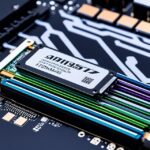Table of Contents
Today, knowing how much power an SSD uses is key for both shoppers and companies. SSDs are seen as more power-efficient than old Hard Disk Drives (HDDs). This is because SSDs don’t have parts that move. Yet, it’s not always simple, especially when we compare them based on how they perform and how much power they use in different situations. For example, standard 2.5” SATA drives use about 7.5W, but the top M.2 NVMe drives can use more than 10W when they’re working hard1. On the other hand, USB external SSDs try to be more power-efficient, usually using around 4.5W at 5V1. We’re going to clear up the confusion around how much power SSDs use in different conditions.
How much power SSDs use can greatly change, and it really matters whether they are idle or in use. When not doing much, SSDs on a desktop might use between 20-100mW, while on laptops they can use as little as ~5mW1. As we dive into SSD technology, it’s clear that the type of SSD and what we use it for greatly affect how much electricity it needs.
Key Takeaways
- SSDs typically consume between 4.5W to upwards of 10W, depending on the model and usage.
- The most advanced M.2 NVMe drives can surpass 10W during intensive tasks.
- Idle power consumption for SSDs can vary greatly, impacting overall energy efficiency.
- Understanding power patterns can assist users in selecting the most efficient drives for their needs.
- Higher capacity SSDs may consume more power than their lower capacity counterparts.
Understanding SSD Power Consumption
Power use is essential when looking at Solid State Drives (SSDs). Even though they are small, some SSDs use more power than old hard drives during big tasks. The power consumption of an SSD depends a lot on its type. Things like speed and how hard it works are important. For example, normal SSDs use about 2-3 watts when working, while old hard drives might use 6-7 watts. This shows that SSDs are better at saving power in situations where energy matters2.
It’s important to know the difference between ‘peak power draw’ and ‘average power draw’. Peak power is the most power an SSD uses during busy data tasks. Average power is what it uses when it’s less busy. SSDs are good at going into a low-power mode when they’re not doing much. They can use as little as 0.5 watts when idle2.
The M.2 SSDs are high-end and deal with data fast, even when very busy. These need better cooling which might need more power but keeps them working well. Different shapes, like EDSFF, help data centres manage power better. This makes storage faster and greener, lowering the impact on the environment3.
Understanding SSD power use is key for users who want to make their systems better. Companies are always trying to make SSDs use power more wisely. They aim to balance how well they work with how much energy they use. This makes SSDs a smart pick, especially where both speed and power matter.
Comparing SSDs and HDDs: A Power Perspective
Looking at SSD vs HDD power draw, SSDs use less power than HDDs when operating normally. SATA SSDs keep their power draw under 5W. Meanwhile, M.2 SSDs might reach 7-8W under heavy use4. HDDs need more power at startup and when working hard. This can reduce a laptop’s battery life. By switching to an SSD, you could gain about 30-45 minutes of battery life4.
SSDs handle power more efficiently. They may have a short surge in power for charging and starting up. But, they soon drop to lower idle power, sometimes less than 3mW4. HDDs, however, keep using power even for small tasks when not busy. This makes them use more power overall, if they are the main storage5.
The comparison of energy between SSDs and HDDs shows that SSDs perform better. Even with occasional high power use, SSDs complete tasks quicker. This means they need less power over time during operations5. SSDs are not just faster but also better at saving power.
| Feature | SSD | HDD |
|---|---|---|
| Typical Power Draw | Under 5W for SATA, 7-8W under load | Higher during startup and operational spins |
| Idle Power Consumption | Under 3mW, even as low as 10mW | Constant with minor reads, higher overall |
| Impact on Battery Life | Up to 30-45 minutes longer in laptops | More drain, especially in powering spin-up |
| Average Power Draw | Lower overall, despite higher peaks | Higher average during active use |
Power Usage Patterns of Different SSD Types
Getting to know about SSD types power consumption helps people make smart choices about energy use. Each SSD type uses a different amount of power, which affects its performance. Let’s look at how much power various SSDs use.
| SSD Type | Idle Power (W) | Read Power (W) | Write Power (W) |
|---|---|---|---|
| 2.5-Inch SATA SSD | 0.5 – 1.0 | 2.0 – 3.0 | 3.0 – 4.0 |
| mSATA SSD | 0.5 – 1.0 | 2.0 – 3.0 | 3.0 – 4.0 |
| M.2 SATA SSD | 0.3 – 0.8 | 1.0 – 2.5 | 2.5 – 3.5 |
| M.2 PCI-Express NVMe SSD | 0.5 – 1.5 | 4.0 – 6.0 | 6.0 – 9.0 |
| Add-in-Card PCIe SSD | 0.7 – 1.5 | 4.5 – 8.0 | 8.0 – 12.0 |
Looking at the data, we see 2.5 inch SSD power usage is usually less than M.2 and Add-in-Card types. This comparison is based on their idle, read, and write power. M.2 PCI-Express NVMe SSDs, for instance, need more power when working hard. On the other hand, M.2 SATA SSDs are more power-efficient, making them good for battery-saving.
Things like temperature and how much you use your SSD can change how much power the M.2 SSD uses. It’s crucial you consider what you need your SSD for. For more about SSD power use, look at this detailed guide. Knowing these details helps you pick the right SSD for both good performance and energy savings.
How Much Watts Does SSD Use?
Understanding SSD wattage is important for both personal and large-scale use. We need to look at average use and break it down by type and activity. The power difference between SSDs and HDDs shows the potential for efficiency and savings.
Power Consumption Breakdown by SSD Type
SSD power use varies by type and situation. For example, a 2.5” SATA SSD might use about 7.5 watts when it’s working hard. M.2 SSDs can go up to 10 watts because they perform better1. High-end M.2 NVMe SSDs might use even more power, trying to be both fast and efficient. In contrast, normal HDDs can use about 6-7 watts or more when they’re busy2.
| SSD Type | Peak Power Consumption | Idle Power Consumption |
|---|---|---|
| 2.5” SATA SSD | 7.5W | 20-100mW |
| M.2 SSD | Up to 10W | ~5mW (laptop) |
| High-end M.2 NVMe SSD | Exceeds 10W | 3.5W (lower-end NVMe) |
| USB External SSD | 4.5W | (not specified) |
Idle vs Active Power Consumption
When we look at power use, SSDs have a clear edge over HDDs. SSDs only need about 2-3 watts when they are in use. HDDs can need more than double that amount2. Take the CVB SATA SSD. It has special tech to use as little as 0.5 watts when it’s doing nothing2. This huge difference shows how much more efficient SSDs are. Plus, modern SSDs can use barely any power at all when they’re idle, which saves energy1.
Factors Affecting SSD Power Draw
Knowing about SSD power draw factors helps improve its performance and efficiency. There are internal and external factors that affect an SSD’s energy use. These include firmware settings, types of workloads, and the interfaces for connecting.
Drive firmware has a big impact on SSD energy use. For example, SSDs designed for low power use will work differently from those made for speed. Also, whether it’s used in a big data centre or for personal reasons affects power use. Power use is more consistent in data centres due to large-scale processing compared to sporadic use at home.
Keeping SSDs cool is vital for energy efficiency. When SSDs get hot, they use more power, which can slow them down and shorten their life. Effective cooling keeps power use down. Tips on SSD management show that good cooling can stop power increases that cause thermal throttling, according to pcsite.co.uk.
Choosing the right SSD can save energy. For instance, the SK hynix P31 Gold is very efficient, often better than SATA types and uses less energy6. Both SATA and NVMe drives use about the same amount of power, showing consistent energy use across models6. Picking energy-efficient SSDs can greatly improve power management.
| SSD Model | Power Efficiency | Performance Retention |
|---|---|---|
| SK hynix P31 Gold | High | Maintains efficiency |
| Crucial P5 Plus 1TB | Affordable | Moderate |
| OCZ Vertex Turbo | Moderate | 99.5% after TRIM |
By understanding SSD power draw factors, users can enhance their storage. This ensures both high performance and efficient energy use.
Impact of Power Consumption on Performance
It’s essential to know how SSD performance power consumption affects speed to improve system efficiency. Using more power usually means more heat. This can slow down your SSD. For example, a regular 2.5-Inch SATA SSD uses about 4-8 watts when reading data. Meanwhile, mSATA SSDs use about 2-5 watts. But a M.2 PCI-Express NVMe SSD might use 2-8 watts for reading and 3-10 watts for writing7.
Faster SSDs, like the Add-in-Card PCIe types, use more power to process data quickly. They can use 3-7 watts for reading. When writing, this can jump to 15 watts8. If these SSDs get too hot, they can slow down to prevent damage. This shows how using more advanced technology can affect performance.
Managing SSD energy efficiency is key. Turning on power-saving options and managing workloads well helps maintain speed without using too much energy. SSD RAIDs are much more energy-efficient than HDDs. This is great for saving energy in data centres9.
Knowing how power use affects an SSD’s speed is powerful. It leads to smarter choices in SSD use. This means getting the best performance while saving on energy costs.
Steps to Reduce Energy Consumption
Lowering SSD power use is key for better computing efficiency. Using energy saving SSD techniques leads to big energy savings over time. A top method is to turn on the power-saving modes found in many modern SSDs. These modes help manage energy use and can also make the drive last longer.
Keep the SSD firmware updated to ensure top performance and efficiency. Up-to-date firmware greatly improves energy efficiency. This lets users make the most of new power-saving features.
Tuning file systems is crucial in cutting down unneeded write cycles that use extra power. Setting up the file system right can lower update frequency on the SSD. This results in better drive longevity and less energy used.
Keeping an efficient SSD setup helps with SSD efficiency tips. Watching system performance and uninstalling unused apps can lower workload and save energy. Also, picking SSDs that use only 0.6 to 2.8 W can really boost energy efficiency while they work10.
Getting into a routine of defragmenting the SSD sometimes is a good idea. Although SSDs don’t need it as often as HDDs, doing it carefully can still boost performance and efficiency. By following these steps, users can reduce SSD power usage and still enjoy fast solid-state technology.
Conclusion
In exploring SSD power efficiency, we’ve learned how vital it is to know about SSD power use. SSDs use about 2-3 watts when active, much less than the 6-7 watts HDDs need. They are even more efficient during idle times, with some dropping to 0.5 watts112. This shows that SSDs not only use less energy but also outperform HDDs, making them a great choice for computers today.
The need to know about SSD energy use matters to everyone, from individuals to big groups focused on energy costs and the environment. Thanks to improvements like 3D NAND, SSDs are now more energy-efficient and produce less heat. This means less need for cooling in places like data centres1112. All these benefits help make technology more sustainable and eco-friendly.
The aim is to find the right balance between good performance and low power use. By choosing SSDs, we not only get more efficient devices, but we also help make the world greener212.
FAQ
What is SSD power consumption and how does it impact performance?
SSD power consumption is the energy an SSD uses when it works. SSDs use less energy than HDDs because they don’t have moving parts. However, some SSDs need more power, especially when they’re busy, which can affect their performance and lifespan.
How do SSDs compare to HDDs in terms of power usage?
SSDs generally use less power than HDDs. HDDs need more energy to start up and keep their disks spinning. SSDs, on the other hand, have quick surges of power use during tasks but then return to a low power state faster.
Are there differences in power consumption among various SSD types?
Yes, different SSDs use different amounts of power. For example, 2.5-Inch SATA SSDs and M.2 PCI-Express NVMe SSDs have different power needs. They have specific figures for how much power they use when they’re idle, reading, or writing data.
What affects SSD power draw during operation?
Several things impact how much power an SSD uses. The drive’s firmware, what tasks it’s doing, the speed of the connection, and where it’s used matter. Heat management is also important because too much heat can make an SSD use more power.
How can users reduce the energy consumption of their SSDs?
Users can cut down on their SSD’s power use by turning on power-saving settings. It’s also good to keep the SSD’s firmware updated for better performance. Plus, organising files efficiently can help save on energy without losing speed.
What is the significance of peak power draw versus average power draw in SSDs?
Peak power draw is the highest amount of power an SSD uses during busy times. Average power draw is what it uses most of the time. Knowing the difference helps balance performance and energy use.
How does power consumption correlate with the longevity of an SSD?
Using more power can make an SSD hotter, which might slow it down and shorten its life. Keeping power use low and managing heat can make an SSD work better and last longer.
Source Links
- https://sabrent.com/blogs/storage/ssd-power-consumption – SSD Power Consumption and How It’s Managed
- https://www.ssstc.com/knowledge-detail/ssd-vs-hdd-power-efficiency/ – SSDs vs. HDDs: The Green Power Consumption Advantage with CVB SATA SSD
- https://www.snia.org/forums/cmsi/knowledge/formfactors – SSD Form Factors | SNIA
- https://www.tomshardware.com/features/ssd-vs-hdd-hard-drive-difference – SSD vs HDD Tested: What’s the Difference and Which Is Better?
- https://superuser.com/questions/1545690/why-do-2-5-ssds-use-more-power-than-2-5-hdds – why do 2.5″ ssd’s use more power than 2.5″ hdd’s?
- https://community.frame.work/t/low-power-ssd-selection/13562 – Low power SSD selection
- https://www.superssd.com/kb/ssd-power-consumption/ – SSD Power Consumption: What to Expect | SuperSSD
- https://par.nsf.gov/servlets/purl/10050305 – A Comparative Study of HDD and SSD RAIDs? Impact on Server Energy Consumption
- https://storedbits.com/ssd-power-consumption/ – SSD Power Consumption: A Comprehensive Guide – StoredBits.com
- https://www.buildcomputers.net/power-consumption-of-pc-components.html – Typical Power Consumption of PC Components – Power Draw in Watts
- https://www.ssstc.com/knowledge-detail/ssd-power-consumption-green-solution/ – Power Consumption with SSDs: A Greener and Efficient Solution
- https://www.intelice.com/ssd-or-hdd-hard-drives/ – SSD or HDD Hard Drives: Which is Best for Your DC Metro Area Business?



